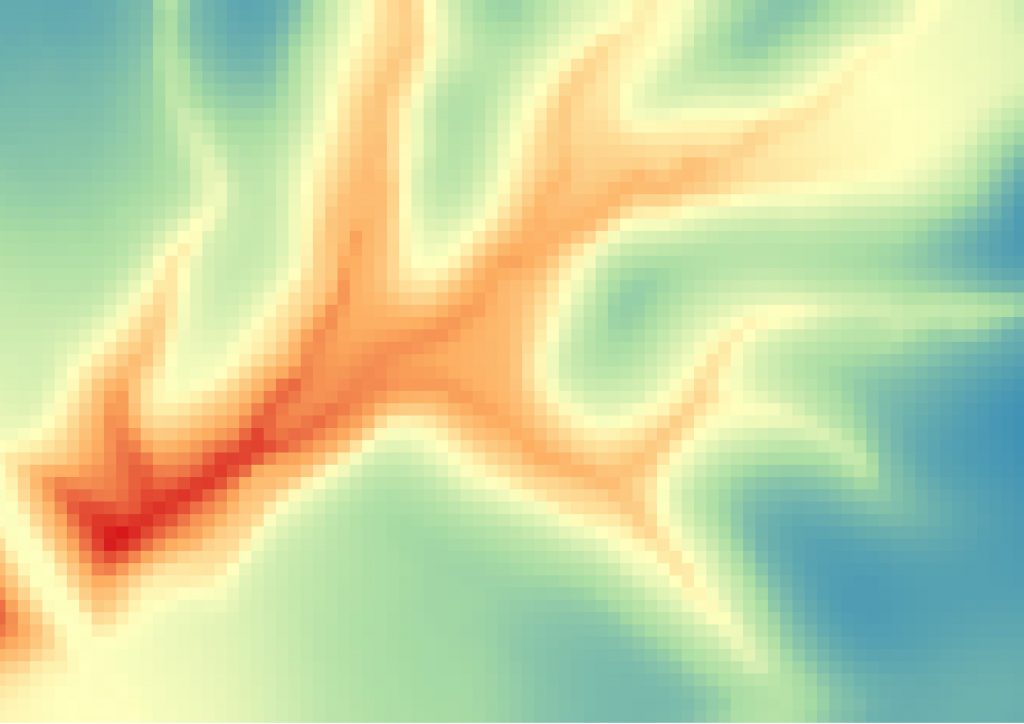
Many global Digital Elevation Models (DEMs), including Copernicus DEM, MERIT DEM, and FABDEM, are delivered in geographic coordinates with fixed angular spacing (for example, 1 arcsecond or 3 arcseconds). While these are often labeled as 30 meter or 90 meter DEMs, the actual ground resolution varies with latitude. This leads to uneven sampling and potential errors in analysis. This post outlines the consequences of assuming constant spatial resolution and proposes the use of Discrete Global Grid Systems (DGGS) as a more accurate and uniform alternative.
The Issue: Inconsistent Ground Spatial Resolution in Arcsecond DEMs
Digital Elevation Models are essential for applications ranging from hydrology and forestry to ecological modeling and hazard assessment. However, a limitation exists in many widely used global DEMs: their spatial resolution is defined in angular units rather than in actual ground distance. Datasets such as Copernicus DEM (GLO 30), MERIT DEM, and FABDEM are distributed using a regular 1 arcsecond (or 3 arcseconds) grid in geographic coordinates (EPSG 4326), which corresponds to approximately 30 meters (or 90 meters) of spacing only at the equator. Toward the poles, the longitudinal spacing of grid cells decreases significantly, reducing the true ground resolution.
Despite this, these DEMs are often referred to by their nominal meter-based resolution. This leads to a common but incorrect assumption that the ground sampling interval is uniform across the globe. In reality, the ground area represented by each pixel is much smaller at high latitudes, introducing inconsistencies that affect modeling, comparison, and spatial inference.
Real-World Consequences of Misuse
Assuming uniform 30 meter or 90 meter cell sizes in arcsecond-gridded DEMs can sometimes have subtle impacts on real-world applications.
Area-based calculations are among the most affected. For example, when estimating forest cover or land use change, assuming a fixed area per pixel can lead to overestimations in high-latitude regions. At 60 degrees latitude, a one arcsecond pixel in the longitudinal direction covers only about half the distance it does at the equator.
Hydrologic modeling also suffers when distance and slope calculations are based on inconsistent pixel dimensions. Flow accumulation paths, watershed boundaries, and runoff estimates may be distorted, especially in regions where the grid cells represent varying physical distances.
Terrain attributes such as slope and aspect become unreliable when calculated directly from geographic-coordinate DEMs without converting to a projected coordinate system. The underestimation of slope at high latitudes can mislead geomorphological assessments and hazard risk models.
In ecological modeling, neighborhood-based analyses, such as habitat suitability and landscape connectivity, rely on spatial context that assumes uniform cell spacing. When grid cells vary in size, the scale of influence around a focal point changes with latitude, introducing bias into models of habitat structure or species movement.
Machine learning models trained on DEM-derived features can also inherit spatial bias. If terrain characteristics are extracted using moving windows that do not represent consistent real-world areas, the resulting models may not generalize well across different latitudinal regions.
Finally, resampling and reprojection operations can introduce artifacts when applied to DEMs with uneven ground spacing. Interpolation methods that assume regular spacing may result in visual distortion or loss of elevation accuracy, particularly in regions far from the equator.
If people are working on analyses that require uniform spatial resolution in meters, one common approach is to reproject the DEM to a projected coordinate reference system, such as UTM or an equal-area projection. However, no single projected CRS is suitable for covering large regions or the entire globe. For example, the UTM system divides the world into sixty zones, and even within Canada alone, multiple UTM zones are used. This makes seamless global or continental-scale analysis difficult unless additional mosaicking, reprojection, or partitioning strategies are employed.
A Solution: Discrete Global Grid Systems (DGGS)
To address these issues, spatial analysts should consider using Discrete Global Grid Systems. Unlike latitude-longitude grids, DGGS divides the Earth’s surface into uniformly sized and shaped cells that maintain equal area across all latitudes. This approach ensures consistent resolution everywhere on Earth and avoids the distortions caused by angular gridding.
DGGS provides a structured, hierarchical framework for organizing spatial data. When elevation models are resampled or integrated using DGGS cells, they support accurate area measurement, consistent sampling, and scalable spatial modeling. These benefits are especially important for global applications such as climate monitoring, carbon accounting, or ecosystem assessment.
Tools and standards supporting DGGS are increasingly available through platforms promoted by the Open Geospatial Consortium and other community efforts. As workflows move toward more reproducible and scalable spatial infrastructure, DGGS offers a pathway to eliminate hidden inconsistencies and ensure spatial integrity.
Conclusion
Many global DEMs, even when labeled as 30 meter or 90 meter products, rely on arcsecond grids that do not preserve consistent ground resolution. Misinterpreting these datasets as uniform in spatial resolution can introduce substantial errors in environmental modeling, hydrology, and ecological analysis. To address these problems, spatial practitioners should adopt equal-area grid frameworks such as DGGS, which provide consistent spatial representation and strengthen the reliability of global geospatial analysis.
This reflection highlights the importance of spatial integrity in global data processing and the potential of DGGS to improve scientific reproducibility and modeling accuracy across environmental and geospatial domains.